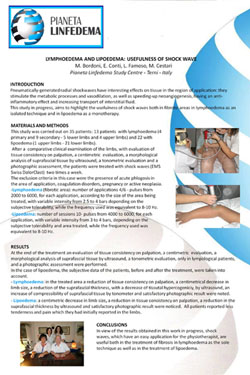INTRODUCTION
Pneumatically-generated radial shockwaves have interesting effects on tissue in the region of application: they stimulate the metabolic processes and vasodilation, as well as speeding-up neoangiogenesis, having an anti-inflammatory effect and increasing transport of interstitial fluid.
This study in progress, aims to highlight the usefulness of shock waves both in fibrotic areas in lymphoedema as an isolated technique and in lipoedema as a monotherapy.
MATERIALS AND METHODS
This study was carried out on 35 patients: 13 patients with lymphoedema (4 primary and 9 secondary – 5 lower limbs and 4 upper limbs) and 22 with lipoedema (1 upper limbs – 21 lower limbs).
After a comparative clinical examination of the limbs, with evaluation of tissue consistency on palpation, a centimetric evaluation, a morphological analysis of suprafascial tissue by ultrasound, a tonometric evaluation and a photographic assessment, the patients were treated with shock waves (EMS Swiss DolorClast) two times a week.
The exclusion criteria in this case were the presence of acute phlogosis in the area of application, coagulation disorders, pregnancy or active neoplasia.
-Lymphoedema (fibrotic area): number of applications 4/6 – pulses from 2000 to 6000, for each application, according to the size of the area being treated, with variable intensity from 2.5 to 4 bars depending on the subjective tolerability, while the frequency used was equivalent to 8-10 Hz.
RESULTS
At the end of the treatment an evaluation of tissue consistency on palpation, a centimetric evaluation, a morphological analysis of suprafascial tissue by ultrasound, a tonometric evaluation, only in lympological patients, and a photographic assessment were performed.
In the case of lipoedema, the subjective data of the patients, before and after the treatment, were taken into account.
- Lymphoedema: in the treated area a reduction of tissue consistency on palpation, a centimetrical decrease in limb size, a reduction of the suprafascial thickness, with a decrease of tissutal hypercogeniciy, by ultrasound, an increase of compressibility of suprafascial tissue by tonometer and satisfactory photographic result were noted.
- Lipoedema: a centimetric decrease in limb size, a reduction in tissue consistency on palpation, a reduction in the suprafascial thickness by ultrasound and satisfactory photographic result were noticed. All patients reported less tenderness and pain which they had initially reported in the limbs.
CONCLUSIONS
In view of the results obtained in this work in progress, shock waves, which have an easy application for the physiotherapist, are useful both in the treatment of fibrosis in lymphoedema as the sole technique as well as in the treatment of lipoedema
